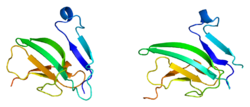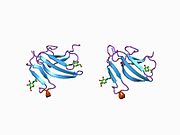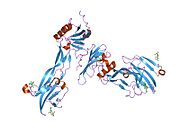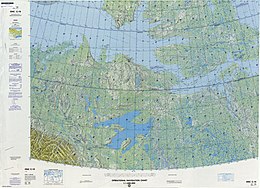ACVR2A
ACVR2A| ACVR2A | |||||||||||||||||||||||||
|---|---|---|---|---|---|---|---|---|---|---|---|---|---|---|---|---|---|---|---|---|---|---|---|---|---|
 | |||||||||||||||||||||||||
| |||||||||||||||||||||||||
| 식별자 | |||||||||||||||||||||||||
| 별칭 | ACVR2A, ACTRII, ACVR2, 활성 A 수용체 유형 2A | ||||||||||||||||||||||||
| 외부 ID | OMIM: 102581 MGI: 102806 HomoloGene: 20391 GeneCard: ACVR2A | ||||||||||||||||||||||||
| |||||||||||||||||||||||||
| |||||||||||||||||||||||||
| |||||||||||||||||||||||||
| 직교체 | |||||||||||||||||||||||||
| 종 | 인간 | 마우스 | |||||||||||||||||||||||
| 엔트레스 | |||||||||||||||||||||||||
| 앙상블 | |||||||||||||||||||||||||
| 유니프로트 | |||||||||||||||||||||||||
| RefSeq(mRNA) | |||||||||||||||||||||||||
| RefSeq(단백질) | |||||||||||||||||||||||||
| 위치(UCSC) | Chr 2: 147.84 – 147.93Mb | Chr 2: 48.7 – 48.79Mb | |||||||||||||||||||||||
| PubMed 검색 | [3] | [4] | |||||||||||||||||||||||
| 위키다타 | |||||||||||||||||||||||||
| |||||||||||||||||||||||||
액티닌 수용체 타입-2A는 인간에서 ACVR2A 유전자에 의해 암호화된 단백질이다.[5][6][7]ACVR2A는 활성형 2 수용체다.
함수
이 유전자는 A형 II 수용체에서 활성(activin)을 인코딩한다.활성은 구조적으로 관련된 신호 단백질의 변형 성장 인자-베타(TGF-베타) 슈퍼 패밀리에 속하는 조광성 성장과 분화 요인이다.활성인은 적어도 2개의 타입 I(I 및 IB) 수용체와 2개의 타입 II(II 및 IIB) 수용체를 포함하는 수용체 세린 키나제의 이질적 복합체를 통해 신호를 보낸다.이 수용체들은 모두 투과성 단백질로, 시스테인이 풍부한 부위의 리간드 결합 세포외 영역, 투과성 영역, 세린/스로닌 특이성이 예측된 세포질 영역으로 구성되어 있다.1형 수용체는 신호 전달에 필수적이며, 2형 수용체는 리간드를 결합하고 1형 수용체를 표현하는데 필요하다.Ⅰ형과 Ⅱ형 수용체는 리간드 결합 후 안정된 콤플렉스를 형성하여 Ⅱ형 수용체별로 Ⅰ형 수용체가 인산화되는 결과를 초래한다.제2형 수용체는 구성성 활력 키나아스로 간주된다.[7]
상호작용
ACVR2A는 다음과 상호 작용하는 것으로 나타났다.
참조
- ^ a b c GRCh38: 앙상블 릴리스 89: ENSG00000121989 - 앙상블, 2017년 5월
- ^ a b c GRCm38: 앙상블 릴리스 89: ENSMUSG000052155 - 앙상블, 2017년 5월
- ^ "Human PubMed Reference:". National Center for Biotechnology Information, U.S. National Library of Medicine.
- ^ "Mouse PubMed Reference:". National Center for Biotechnology Information, U.S. National Library of Medicine.
- ^ Donaldson CJ, Mathews LS, Vale WW (May 1992). "Molecular cloning and binding properties of the human type II activin receptor". Biochem. Biophys. Res. Commun. 184 (1): 310–6. doi:10.1016/0006-291X(92)91194-U. PMID 1314589.
- ^ Bondestam J, Horelli-Kuitunen N, Hildén K, Ritvos O, Aaltonen J (April 2000). "Assignment of ACVR2 and ACVR2B the human activin receptor type II and IIB genes to chromosome bands 2q22.2-->q23.3 and 3p22 and the human follistatin gene (FST) to chromosome 5q11.2 by FISH". Cytogenet. Cell Genet. 87 (3–4): 219–20. doi:10.1159/000015429. PMID 10702675. S2CID 36135054.
- ^ a b "Entrez Gene: ACVR2A activin A receptor, type IIA".
- ^ Lebrun JJ, Takabe K, Chen Y, Vale W (January 1999). "Roles of pathway-specific and inhibitory Smads in activin receptor signaling". Mol. Endocrinol. 13 (1): 15–23. doi:10.1210/mend.13.1.0218. PMID 9892009.
- ^ De Winter JP, De Vries CJ, Van Achterberg TA, Ameerun RF, Feijen A, Sugino H, De Waele P, Huylebroeck D, Verschueren K, Van Den Eijden-Van Raaij AJ (May 1996). "Truncated activin type II receptors inhibit bioactivity by the formation of heteromeric complexes with activin type I. receptors". Exp. Cell Res. 224 (2): 323–34. doi:10.1006/excr.1996.0142. PMID 8612709.
- ^ Lewis KA, Gray PC, Blount AL, MacConell LA, Wiater E, Bilezikjian LM, Vale W (March 2000). "Betaglycan binds inhibin and can mediate functional antagonism of activin signalling". Nature. 404 (6776): 411–4. Bibcode:2000Natur.404..411L. doi:10.1038/35006129. PMID 10746731. S2CID 4393629.
- ^ Martens JW, de Winter JP, Timmerman MA, McLuskey A, van Schaik RH, Themmen AP, de Jong FH (July 1997). "Inhibin interferes with activin signaling at the level of the activin receptor complex in Chinese hamster ovary cells". Endocrinology. 138 (7): 2928–36. doi:10.1210/endo.138.7.5250. PMID 9202237.
- ^ Tsuchida K, Nakatani M, Matsuzaki T, Yamakawa N, Liu Z, Bao Y, Arai KY, Murakami T, Takehara Y, Kurisaki A, Sugino H (October 2004). "Novel factors in regulation of activin signaling". Mol. Cell. Endocrinol. 225 (1–2): 1–8. doi:10.1016/j.mce.2004.02.006. PMID 15451561. S2CID 34666659.
- ^ Matsuzaki T, Hanai S, Kishi H, Liu Z, Bao Y, Kikuchi A, Tsuchida K, Sugino H (May 2002). "Regulation of endocytosis of activin type II receptors by a novel PDZ protein through Ral/Ral-binding protein 1-dependent pathway". J. Biol. Chem. 277 (21): 19008–18. doi:10.1074/jbc.M112472200. PMID 11882656.
외부 링크
- UCSC 게놈 브라우저의 인간 ACVR2A 게놈 위치 및 ACVR2A 유전자 세부 정보 페이지.
추가 읽기
- Welt CK (2002). "The physiology and pathophysiology of inhibin, activin and follistatin in female reproduction". Curr. Opin. Obstet. Gynecol. 14 (3): 317–23. doi:10.1097/00001703-200206000-00012. PMID 12032389. S2CID 44327401.
- Matzuk MM, Bradley A (1992). "Cloning of the human activin receptor cDNA reveals high evolutionary conservation". Biochim. Biophys. Acta. 1130 (1): 105–8. doi:10.1016/0167-4781(92)90472-C. PMID 1311955.
- Mathews LS, Vale WW (1991). "Expression cloning of an activin receptor, a predicted transmembrane serine kinase". Cell. 65 (6): 973–82. doi:10.1016/0092-8674(91)90549-E. PMID 1646080. S2CID 36407277.
- Xu J, McKeehan K, Matsuzaki K, McKeehan WL (1995). "Inhibin antagonizes inhibition of liver cell growth by activin by a dominant-negative mechanism". J. Biol. Chem. 270 (11): 6308–13. doi:10.1074/jbc.270.11.6308. PMID 7890768.
- Attisano L, Cárcamo J, Ventura F, Weis FM, Massagué J, Wrana JL (1993). "Identification of human activin and TGF beta type I receptors that form heteromeric kinase complexes with type II receptors". Cell. 75 (4): 671–80. doi:10.1016/0092-8674(93)90488-C. PMID 8242742. S2CID 25408172.
- Peng C, Huang TH, Jeung EB, Donaldson CJ, Vale WW, Leung PC (1993). "Expression of the type II activin receptor gene in the human placenta". Endocrinology. 133 (6): 3046–9. doi:10.1210/en.133.6.3046. PMID 8243335.
- De Winter JP, De Vries CJ, Van Achterberg TA, Ameerun RF, Feijen A, Sugino H, De Waele P, Huylebroeck D, Verschueren K, Van Den Eijden-Van Raaij AJ (1996). "Truncated activin type II receptors inhibit bioactivity by the formation of heteromeric complexes with activin type I. receptors". Exp. Cell Res. 224 (2): 323–34. doi:10.1006/excr.1996.0142. PMID 8612709.
- Attisano L, Wrana JL, Montalvo E, Massagué J (1996). "Activation of signalling by the activin receptor complex". Mol. Cell. Biol. 16 (3): 1066–73. doi:10.1128/mcb.16.3.1066. PMC 231089. PMID 8622651.
- Liu QY, Niranjan B, Gomes P, Gomm JJ, Davies D, Coombes RC, Buluwela L (1996). "Inhibitory effects of activin on the growth and morpholgenesis of primary and transformed mammary epithelial cells". Cancer Res. 56 (5): 1155–63. PMID 8640777.
- Nishitoh H, Ichijo H, Kimura M, Matsumoto T, Makishima F, Yamaguchi A, Yamashita H, Enomoto S, Miyazono K (1996). "Identification of type I and type II serine/threonine kinase receptors for growth/differentiation factor-5". J. Biol. Chem. 271 (35): 21345–52. doi:10.1074/jbc.271.35.21345. PMID 8702914.
- Lebrun JJ, Vale WW (1997). "Activin and inhibin have antagonistic effects on ligand-dependent heteromerization of the type I and type II activin receptors and human erythroid differentiation". Mol. Cell. Biol. 17 (3): 1682–91. doi:10.1128/mcb.17.3.1682. PMC 231893. PMID 9032295.
- Macías-Silva M, Hoodless PA, Tang SJ, Buchwald M, Wrana JL (1998). "Specific activation of Smad1 signaling pathways by the BMP7 type I receptor, ALK2". J. Biol. Chem. 273 (40): 25628–36. doi:10.1074/jbc.273.40.25628. PMID 9748228.
- Barbara NP, Wrana JL, Letarte M (1999). "Endoglin is an accessory protein that interacts with the signaling receptor complex of multiple members of the transforming growth factor-beta superfamily". J. Biol. Chem. 274 (2): 584–94. doi:10.1074/jbc.274.2.584. PMID 9872992.
- Lux A, Attisano L, Marchuk DA (1999). "Assignment of transforming growth factor beta1 and beta3 and a third new ligand to the type I receptor ALK-1". J. Biol. Chem. 274 (15): 9984–92. doi:10.1074/jbc.274.15.9984. PMID 10187774.
- D'Abronzo FH, Swearingen B, Klibanski A, Alexander JM (1999). "Mutational analysis of activin/transforming growth factor-beta type I and type II receptor kinases in human pituitary tumors". J. Clin. Endocrinol. Metab. 84 (5): 1716–21. doi:10.1210/jc.84.5.1716. PMID 10323406.
- Ebisawa T, Tada K, Kitajima I, Tojo K, Sampath TK, Kawabata M, Miyazono K, Imamura T (1999). "Characterization of bone morphogenetic protein-6 signaling pathways in osteoblast differentiation". J. Cell Sci. 112 (20): 3519–27. PMID 10504300.
- van Schaik RH, Wierikx CD, Timmerman MA, Oomen MH, van Weerden WM, van der Kwast TH, van Steenbrugge GJ, de Jong FH (2000). "Variations in activin receptor, inhibin/activin subunit and follistatin mRNAs in human prostate tumour tissues". Br. J. Cancer. 82 (1): 112–7. doi:10.1054/bjoc.1999.0886. PMC 2363208. PMID 10638976.
- Shoji H, Tsuchida K, Kishi H, Yamakawa N, Matsuzaki T, Liu Z, Nakamura T, Sugino H (2000). "Identification and characterization of a PDZ protein that interacts with activin type II receptors". J. Biol. Chem. 275 (8): 5485–92. doi:10.1074/jbc.275.8.5485. PMID 10681527.









